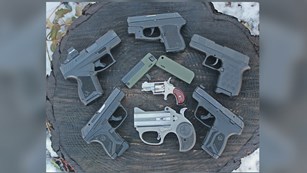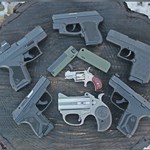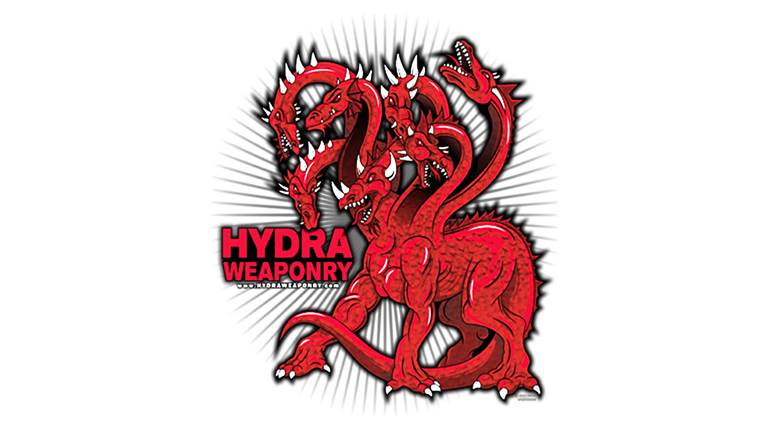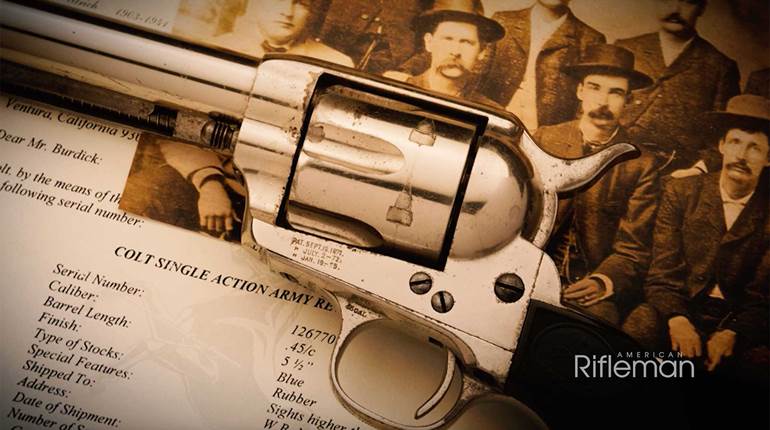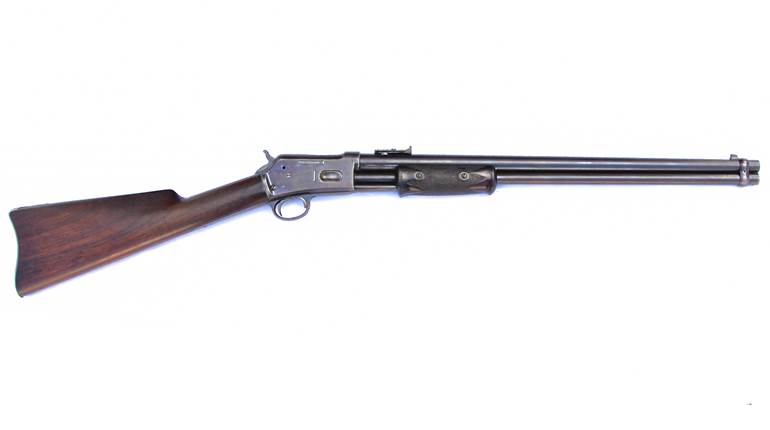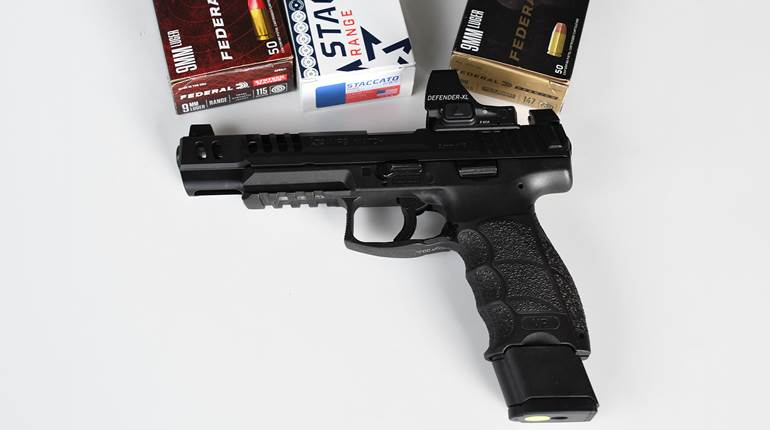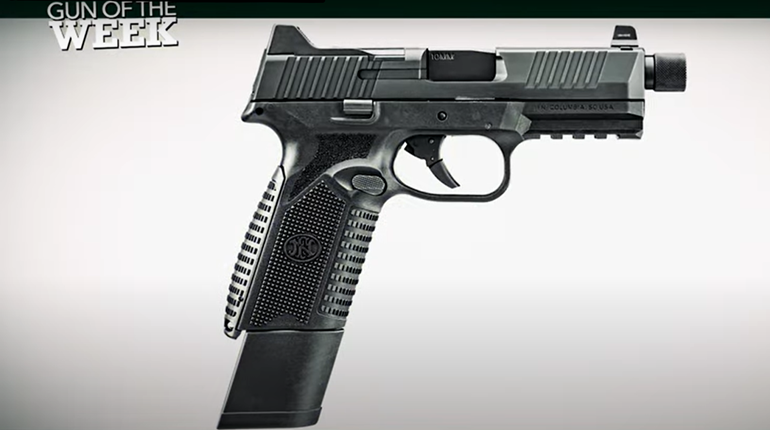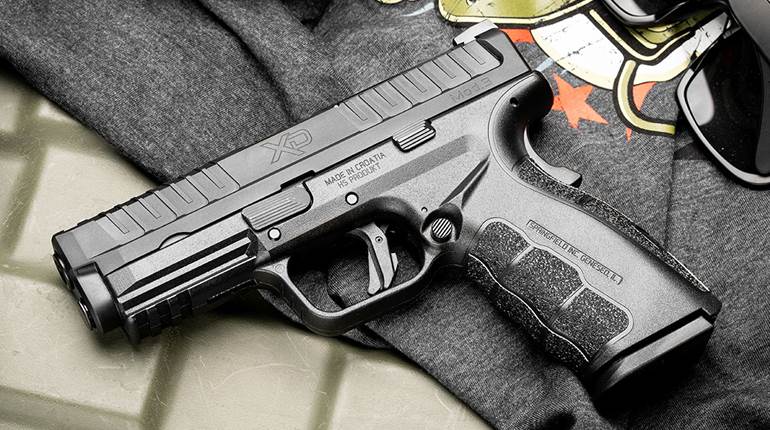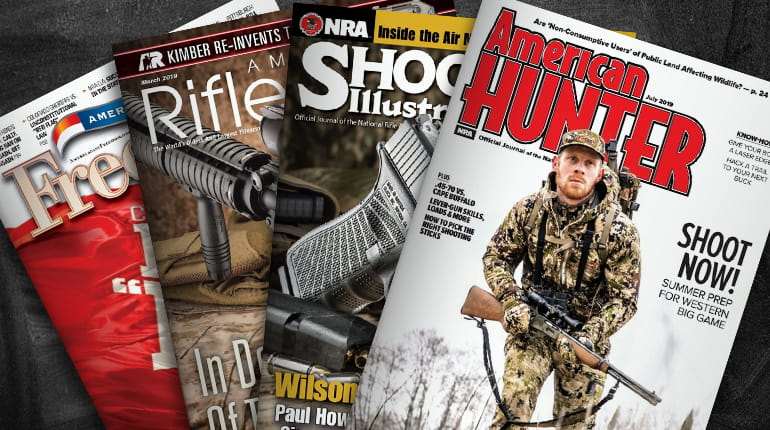
Max Knight added a bit of lore in describing Reid’s Knuckle Dusters in his May 18, 1958 article in the Palladium-Item, in which he defined Reid’s Derringer Knuckle Duster “as a product of the riverboat days of the old Mississippi River. This … five shot repeater, with butt shaped in the form of a hand knuckle … gave the [riverboat] gambler fire power but also a hand weapon of defense.”
Irish-born James Reid, an émigré from Glasgow, Scotland, landed on American shores in 1857 with his young family in tow. He didn’t arrive empty-handed; he had cash in his pocket and was an experienced machinist. First settling in New Jersey, the Reids soon moved to New York City. Somehow this Protestant Irishman foresaw a demand for pocket pistols. Did he see urban New Jersey or New York as so dangerous that they offered a market for his pistols? It was while living in New York City that Reid began his gun manufacturing business.
In the 1863 New York City directory, he was recorded as residing at 171 East 26th St. with "pistolmaker" listed as his occupation. According to Taylor G. Bowen’s work, James Reid and his Catskill Knuckledusters, it was during this time that Reid began making his first guns. According to Gluckman and Satterlee’s American Gun Makers, William Irving, also of New York City, manufactured Reid’s Knuckle Dusters, but this ceased after 1863 due to the infringement of the Rollin White Patent that was owned by his much larger competitor, Smith & Wesson. It also appears that Reid may have produced firearms for James P. Fitch, another gunmaker at this time.
 Featuring a scroll-engraved silver-plated brass frame with a finger-holt grip, shown above, the Reid "My Friend" Knuckle Duster Revolver, Serial No. 7048, came in .22 cal. with a 1 1/2" seven-shot steel cylinder. This item was sold on Dec. 8, 2013, for $1,000. Photo courtesy of HA.com.
Featuring a scroll-engraved silver-plated brass frame with a finger-holt grip, shown above, the Reid "My Friend" Knuckle Duster Revolver, Serial No. 7048, came in .22 cal. with a 1 1/2" seven-shot steel cylinder. This item was sold on Dec. 8, 2013, for $1,000. Photo courtesy of HA.com.
It was within this period of time that James Reid’s daughter, Annie Jane, experienced more acute suffering from a malady affecting her lungs. Physicians treating 9-year-old Annie Jane recommended she leave the confines of the city to escape the deplorable sanitation, the stifling urban air and disease-laden drinking water. Following the doctors’ suggestion, the Reid family left New York City for the fresh country air of Catskill, N.Y.
But prior to leaving for Catskill, Reid began work on a new design for his pistols. This novel concept was a small revolver that could fit into the pocket of one’s vest or trousers. This firearm also served a dual purpose. It could be employed not only as a small-caliber pistol, but as a tool of self-defense. After firing the rounds, the knuckle part of Reid’s new pistol that he christened the "Knuckle Duster," could be utilized to bludgeon an adversary.
 Patent drawing: James Reid US 51752 UNITED STATES PATENT OFFICE. JAMES REID, OF CATSKILL, NEW YORK. IMPROVEMENT IN REVOLVING FIRE-ARMS. Specification forming part of Letters Patent No. 51,752, dated Dec. 26, 1865.
Patent drawing: James Reid US 51752 UNITED STATES PATENT OFFICE. JAMES REID, OF CATSKILL, NEW YORK. IMPROVEMENT IN REVOLVING FIRE-ARMS. Specification forming part of Letters Patent No. 51,752, dated Dec. 26, 1865.
The July 9, 1864, issue of the Catskill Examiner printed the following notice: "Pistol Factory—It is rumored that a company have bought the old paper mill site at Cauterskill with the intention of erecting thereon a pistol factory." Reid began operating a grist mill on site where he advertised, he could “grind all sorts of grain.” The enterprise must have proved successful, allowing him the next three years to ready his gun manufactory.
In December 1865, Reid was granted a patent for an "Improvement in Revolving Fire Arms." This was based, to a degree, on Reid’s contention that, "My invention is applied to a series of short barrels mounted on a center-pin ... I form the handle with a bow behind the trigger-shield so that the implement may be held securely in the hand and used for protection after the barrels may have been discharged, or before it becomes necessary to use them."
The mechanism involves a cylinder that rotates on a center pin. When loading the Knuckle Duster, that center pin is detached from the frame. This permits one to remove the cylinder to load it. There was one important design flaw; the cylinder pin had right-hand threads. As a result, the pin loosened as the cylinder rotated to the right. Reid rectified this by switching the cylinder pin to revolve to the left. A safety mechanism locked the gun, so its firing pin was always secured between two chambers. The second design feature, referred to earlier, connected the spur trigger to the bottom of the grip to form a metal bow. This was a unique design for its time. With this knuckle bow, one could hit an opponent without injuring one’s hand. Reid created this dual-purpose self-defense tool with a strategy in mind, believing that not every altercation should end in a fatality. In his own words, "Never shoot a man if you can knock him down."
 Reid "My Friend" Knuckle Duster Revolver, above, Serial No. 6749, .32-cal., shown with 1 5/8" blued-finish, five-shot cylinder. The gun features scroll engraving on its brass frame and grip with finger hole. Photo courtesy of HA.com.
Reid "My Friend" Knuckle Duster Revolver, above, Serial No. 6749, .32-cal., shown with 1 5/8" blued-finish, five-shot cylinder. The gun features scroll engraving on its brass frame and grip with finger hole. Photo courtesy of HA.com.
His Knuckle Duster was an uncomplicated single-action creation, wherein the hammer was of a rounded "birdshead" design. This prevented the gun from being ensnared when pulled out of a pocket. He found that by engraving the frames, it relaxed any jagged edges and camouflaged imperfections left behind in the casting process. Reid’s son, James, Jr., helped in this phase of production. All the Reid Knuckle Duster were nicely engraved with a floral scroll.
But manufacturing in earnest of Reid’s recently patented Knuckle Duster pistols would have to wait. The aforementioned Rollin Patent owned by Smith & Wesson, would not expire until April 3, 1869. Reid jumped the gun a bit and started production sometime in 1868. But he had kept busy in the interim from 1865 to 1869 with the grist-mill operation. This kept him financially solvent until he could start production of his pistols.
 Contained in scroll and dragon engraved brass case featuring interior wood and green felt with cutout bullet compartments, this James Reid's "My Friend" sold on Dec 8, 2013, for $1,625 at Heritage Auctions. Photo courtesy of HA.com.
Contained in scroll and dragon engraved brass case featuring interior wood and green felt with cutout bullet compartments, this James Reid's "My Friend" sold on Dec 8, 2013, for $1,625 at Heritage Auctions. Photo courtesy of HA.com.
With the cessation of Smith & Wesson’s patent in 1869, Reid began manufacturing his Knuckle Dusters. The .22 Knuckle Duster was his best-seller. The seven-shot, .22 Short Knuckle Duster’s frame sported that knuckle. It was manufactured with both silver-plated brass and blued-iron frames in New York, from 1868 to 1882. The total production estimate was in excess 10,000. In 1873, the .22-cal. Knuckle Duster sold for $10; this price included 100 cartridges. Three years later, they retailed for between $8 and $8.50.
All his early Knuckle Duster were engraved with the signature "My Friend." Reid produced multiple calibers of his Knuckle Dusters. His .32-cal. gun was a step up from his .22, and as he had done with the .22 cal. model, he did away with the safety latch. As production wore down, Reid transitioned to an iron frame finished in either nickel or silver. The .32 carried a price of $12 for the Knuckle Duster and 50 cartridges. This model did rather well, with more than 3,000 pistols sold.
The third type included in his inventory was the .41-cal. Knuckle Duster. It definitely was not anyone’s favorite for a number of reasons; people thought it too unwieldly and too heavy, leaving it awkward to carry and difficult to fire quickly. Both the .32- and .41-cal. versions were five-shooters. This latter pistol was sold as "J. Reid’s Derringer." Reid’s serial number method for his knuckle-dusters is quite simple. The numbers start with the revolvers manufactured in New York City and continue on through the entire complement of his pistols, irrespective of the model.
 This .41-caliber Knuckle Duster was heavy, awkward and probably difficult to shoot. It was inconvenient to carry in a pocket. It doesn’t appear to have ever have been advertised, and lack of demand seems to have relegated it to about 150 units. Photo courtesy of Rock Island Auction.
This .41-caliber Knuckle Duster was heavy, awkward and probably difficult to shoot. It was inconvenient to carry in a pocket. It doesn’t appear to have ever have been advertised, and lack of demand seems to have relegated it to about 150 units. Photo courtesy of Rock Island Auction.
James had invested heavily in his gun manufactory to the tune of $11,000 in 1870. He ran quite the operation. In all, he had a workforce of 12 men to run his seven lathes, one drill, one forge and one polishing machine. Included in his labor force was his brother, Samuel, who served as a machinist. His brother-in-law, William Williamson, was also a machinist at the factory. It appears other family members were also involved. In the year between June 1, 1869 and May 31, 1870, his employees earned a total of $7,000. On June 1, 1870, the value of his inventory of 2,000 pistols was estimated at $14,000.
With the opening of the 1870s, business was thriving. Aside from being involved in the manufacture of the Knuckle Dusters, Reid visited retail outlets to peddle his wares. During the years that his Catskill manufactory was in operation, Reid produced somewhere near 14,000 Knuckle Duster. In its day, this dual-purpose arm gained broad popularity. But with the Panic of 1873, production halved, from 1,400 produced in 1872 to 700 in 1873.
During this financial downturn, Reid cut workers from his staff in order to defray labor costs and looked into other avenues to boost sales. He came up with the idea of adding a 3" barrel to his standard .32 Knuckleduster. Later, he fashioned one with a 1 3/4" barrel. His reasoning for these adaptations is unknown, but in any case, gun buyers showed little interest in these barreled pistols. Production of the units ceased after only 350 were made.
 The Reid home on Cauterskill Road in Catskill. Photo courtesy of PorcupineSoup.com.
The Reid home on Cauterskill Road in Catskill. Photo courtesy of PorcupineSoup.com.
The lethargic economy of 1883 struck the death knell for James Reid’s Catskill gun manufactory. The depression really cut into sales, and a large loan, and possibly more than one, remained unpaid, leading to his fiscal downfall. In the end, James Reid sold his property for an undetermined amount, and in 1884, moved with his entire extended family to what is now Watervliet. From owning his own lucrative business, he was delegated to carrying on a trade for several years as machinist for U.S. Arsenal in West Troy. He passed away on May 28, 1898, and was interred with Masonic rites in the Albany Rural Cemetery.
Today these Knuckle Dusters are highly sought after by collectors. The .22-cal. guns are more common and easier to find, and carry a price around $1,000 to $2,000. A Reid .32-cal. My Friend Knuckle Duster Revolver is on the block for a May 2024 Rock Island Auction, with an estimated sale price of $1,600 to $2,500. But the .41-cal. is the rarest of the three. A James Reid .41-cal. five-shot "Knuckleduster" revolver sold for $14,000 in November 2015.
.22-Cal. Knuckle Duster Specifications:
Chambering: .22 Rimfire (short)
Overall length: 4 1/4"
Cylinder: 1 7/16" long, round with seven chambers (not rifled)
Hammer: Birdhead-style
Frame: Brass with and then without safety latch or Iron without safety latch
Finish: Silver or nickel (some blued cylinders exist)
Estimated period of manufacture: 1868 through 1882
Estimated production: 10,000+
Markings: MY FRIEND on left rear of bottom strap or MY FRIEND PATD DEC. 26, 1865 on left side of top cylinder strap.
.32-Cal. Knuckle Duster Specifications:
Chambering: .32 Rimfire
Overall length: 4 3/4”
Cylinder: 1 11/16" long, round with five chambers (not rifled)
Hammer: Birdhead-style
Frame: Brass with and then without safety latch or Iron without safety latch
Finish: Silver or nickel (some blued cylinders exist)
Estimated Period Of Manufacture: 1870 through 1882
Estimated Production: 3,100
Markings: MY FRIEND PATD DEC. 26, 1865 on left side of top cylinder strap.
.41-Cal. Knuckle Duster Specifications:
Chmabering: .41 Rimfire
Overall length: 4 1/4"
Cylinder: 1 11/16" long, round with five chambers (rifled)
Hammer: Birdhead-style
Frame: brass with safety latch
Finish: silver with blued cylinder
Estimated Period Of Manufacture: 1870 through 1872
Estimated Production: 150
Markings: J. REID’S DERRINGER / PATD. DEC 26, 1865 on two lines on the top cylinder strap




